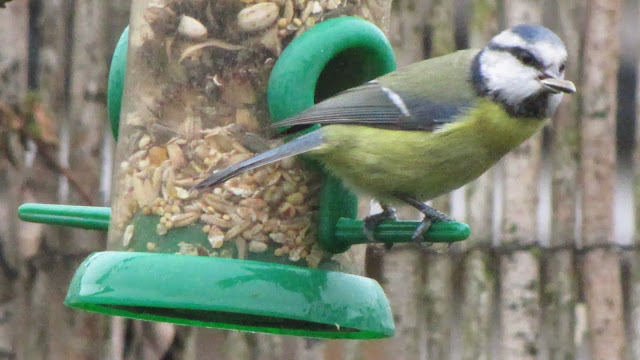Watch And Learn
A rush of wings followed by a noisy argument of greedy beaks: starlings landing in a rowan tree shake it a bit, dislodging bright orange beads that ping to the ground and roll into a colourful heap. Earlier this year I saw a municipal tree axed and fed into a grinder because someone had complained to the district council too many times about its berries blocking their drain. Just up the road a budget is shared out among local government and community groups to enhance local patches with orchard and hedge planting packages; I'm helping to plant a hedge this weekend.
It's a bumper year for berries. One of the best places to watch out for birds feasting on them is at supermarkets and service stations, where rowans and cotoneasters are concreted in among the cars. Waxwings are a startling distraction from the 'Buy 1 Get 1 Free deals'. Less exotic species are beginning to venture into my garden. I had house sparrows, starlings and a blue-tit on my feeder as soon as I'd arranged a rustic branch ensemble by fixing it into the base of a sunshade last week. The birds are more obliging now that my dog is less keen on sunbathing outside.
Attracting birds is often a case of finding the right stick. They need a look-out post and branches or sticks to advance along safely. Years ago when my parents were landscaping their garden they created a large pond. I found a stick with a nice angle to it and put it in the bank. A kingfisher found it instantly.
Their garden is a place brimful of birds. After I'd left home and was living in London I could hear birdsong when I spoke to my mother on the phone. She was dismayed by the sirens wailing at my end. Diesel silted up the window sills, but a woodpigeon lulled me as it cooed fatly in the branches of a London plane outside my bedroom window. My mother would conjure up an avian theatre for me - as she does today. She's been observing a jay observing a squirrel. The bird follows the squirrel around, then turns its attention to a green woodpecker. She knows the jay is after the rodent's cache of acorns or walnuts, and I wonder if it's after the woodpecker's ants. I remember the illustrations in picture books of jays with outstretched wings held limply over ant nests, wearing the same stupefied look I've seen on sunbathing birds. This behaviour is thought to be a deterrent against parasites. Perhaps our strange human habit of watching other creatures is about primal opportunism. Think of honey-guide birds leading the tribe to a luxurious sugar source.
It's a bumper year for berries. One of the best places to watch out for birds feasting on them is at supermarkets and service stations, where rowans and cotoneasters are concreted in among the cars. Waxwings are a startling distraction from the 'Buy 1 Get 1 Free deals'. Less exotic species are beginning to venture into my garden. I had house sparrows, starlings and a blue-tit on my feeder as soon as I'd arranged a rustic branch ensemble by fixing it into the base of a sunshade last week. The birds are more obliging now that my dog is less keen on sunbathing outside.
Attracting birds is often a case of finding the right stick. They need a look-out post and branches or sticks to advance along safely. Years ago when my parents were landscaping their garden they created a large pond. I found a stick with a nice angle to it and put it in the bank. A kingfisher found it instantly.
Their garden is a place brimful of birds. After I'd left home and was living in London I could hear birdsong when I spoke to my mother on the phone. She was dismayed by the sirens wailing at my end. Diesel silted up the window sills, but a woodpigeon lulled me as it cooed fatly in the branches of a London plane outside my bedroom window. My mother would conjure up an avian theatre for me - as she does today. She's been observing a jay observing a squirrel. The bird follows the squirrel around, then turns its attention to a green woodpecker. She knows the jay is after the rodent's cache of acorns or walnuts, and I wonder if it's after the woodpecker's ants. I remember the illustrations in picture books of jays with outstretched wings held limply over ant nests, wearing the same stupefied look I've seen on sunbathing birds. This behaviour is thought to be a deterrent against parasites. Perhaps our strange human habit of watching other creatures is about primal opportunism. Think of honey-guide birds leading the tribe to a luxurious sugar source.

Comments
Post a Comment